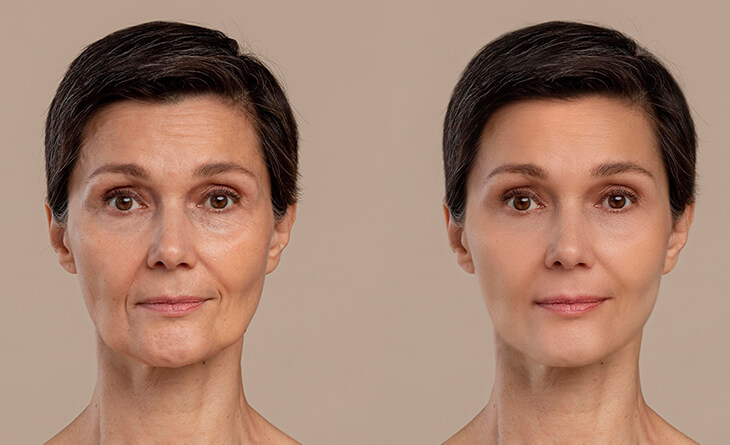Facelift: What Is It, Recovery & What to Expect
Time affects everyone; for some, that impact may be seen as a noticeable indication of facial aging. Sagging skin, deeper wrinkles, and jowls can all contribute to a dull look that impacts one’s appearance and confidence. In that case, people seek cosmetic procedures, and facelift surgery is one of them. But what is it, what is the recovery period, and what can you expect after the procedure? Let’s explore!
What is a Facelift?
A facelift, also known as rhytidectomy, is a surgical procedure that helps you to improve the visible signs of aging by lifting and tightening the underlying tissues and muscles of the face and neck, removing excess skin, and repositioning the skin. It addresses sagging skin, deepens creases, and smooths out wrinkles, particularly around the cheeks, jawline, and neck.
Different facelift surgery procedures are available depending on your desired results and focus areas like the midface, cheeks, jawline, or neck. The most popular options include:
Traditional Facelift: A traditional facelift lifts and tightens sagging facial skin and underlying tissues through incisions around the ears and hairline. Excess skin and fat are removed, and muscles are repositioned for a youthful appearance.
SMAS Facelift (SMAS Rhytidectomy): Unlike traditional facelifts, an SMAS facelift tightens the underlying muscle layer for more natural and long-lasting results in the lower two-thirds of your face. It also tackles excess skin and fat for a sculpted look.
Deep Plane Facelift: Deep plane facelift surgery involves lifting your superficial musculoaponeurotic system, the underlying muscle layer, and the overlying fat and skin as a single unit. This comprehensive approach allows the surgeon to simultaneously address multiple signs of aging, such as jowls, sagging cheeks, and neck wrinkles.
Mid Facelift: Mid-facelift rejuvenates the central part of your face, focusing on the cheek area. It involves strategically adjusting the underlying tissues and smoothing the skin for a more youthful appearance.
Mini Facelift: Mini-facelifts help to address early sagging in the lower face and neck and offer a quicker, gentler alternative to full facelifts. This procedure, especially suited for younger individuals, delivers noticeable rejuvenation with minimal disruption.
Cutaneous (skin) Facelift: The cutaneous facelift surgery procedure rejuvenates the appearance of the neck and lower face by focusing on the skin.

Procedure of Facelift
Facelifts are typically performed on an outpatient basis and can take four to five hours, depending on the extent of the surgery. The process generally involves the following steps:
Consultation: Like any surgical procedure, a facelift starts with a thorough consultation with a board-certified plastic surgeon to discuss your goals, medical history, and expectations. Your surgeon will also advise you to stop taking some medications and quit smoking for a few weeks before surgery.
Anesthesia: On the day of the facelift surgery, your plastic surgeon will put you under anesthesia so that you don’t feel discomfort during the procedure. There are two types of anesthesia: general anesthesia and local anesthesia. The type of anesthesia depends on the type of surgery and your individual situation.
Incision: After giving you anesthesia, your surgeon will make small incisions, often along the hairline and around the ears, to minimize visible scarring.
Tissue Repositioning and Skin Removal: After that, the surgeon will lift the lifts and reposition the underlying facial tissues to address sagging and restore a more youthful contour. Also, remove excess skin to eliminate wrinkles and fine lines, contributing to a smoother appearance. Any other modifications are also done.
Incision Closure: After completing the facelift surgery procedure, your surgeon will carefully close the incisions with sutures or staples; in some cases, surgical drains may be inserted to prevent fluid buildup.
Recovery After Facelift
While the recovery time from facelift surgery varies from patient to patient, it takes two to three months to witness the final outcome.
Immediately after the procedure, you may experience bruising, swelling, and discomfort, which is normal and subsides within two to three days. Your surgeon will also prescribe some pain medications to manage the discomfort.
After facelift surgery, scars will initially be red and raised but gradually flatten and fade over time. You can use scar creams or gels to help improve their appearance. Your surgeon will provide some specific instructions like taking prescribed medications, sleeping in an elevated position, and caring for your wound.
During the recovery period, you will also need to avoid strenuous activities that can put you under strain and increase the risk of complications.

What to Expect?
Immediate Changes:
The most obvious immediate effect of the facelift surgery procedure is a noticeable reduction in sagging facial and neck skin. This can lead to a more lifted and youthful appearance. Deep wrinkles and lines around the mouth, nose, and eyes are often softened and reduced, giving the skin a smoother texture. The jawline appears more defined and contoured, especially if a neck lift is performed with the facelift. If you have excess fullness in your cheeks, it can help to sculpt and define them, giving your face a more balanced look.
Gradual Changes:
As the swelling subsides and the tissues settle, your face may regain some lost volume, resulting in a fuller and more youthful appearance. Over time, the skin may appear thicker and more elastic, with a reduction in fine lines and wrinkles. The initial scars from the incisions will gradually fade and become less noticeable.
Overall Results:
The overall effect of a facelift surgery procedure is to create a more youthful and refreshed appearance. You may look and feel several years younger after the procedure. Many people experience a boost in confidence and self-esteem after a successful facelift. This can be due to the positive changes in their appearance and the feeling of taking control of their aging process.
While a facelift can significantly improve your appearance and visible signs of ageing, it cannot stop the aging process altogether. You can expect to see some continued signs of aging over time.
Take Action!
Facelift surgery can be a transformative procedure, restoring confidence and a more youthful appearance for those seeking to combat the signs of aging. While the recovery process requires patience and attention, the long-lasting effects often make it a worthwhile investment for individuals looking to rejuvenate their facial aesthetics.
As with any surgical procedure, thorough research and consultation with a qualified plastic surgeon are essential to ensure realistic expectations and a successful outcome. If you want a rejuvenated look, look no further than Dr Lokesh Handa, a board-certified plastic surgeon in Delhi.

Dr. Lokesh Handa
M.S, M.Ch
Sr Consultant Plastic, Aesthetic and
Hair Transplant Surgeon
Dr. Lokesh Handa, a board-certified plastic surgeon with over 15 years of experience, holds esteemed titles of M.S. and M.Ch. He serves as a Senior Consultant in Plastic, Aesthetic, and Hair Transplant Surgery.
As the Director of Med Esthetiks, his commitment to excellence is evident. Dr. Lokesh Handa is a distinguished member of renowned organizations, including ISAPS (International Society of Aesthetic Plastic Surgeons), APSI (Association of Plastic Surgeons of India), and IAAPS (Indian Association of Aesthetic Plastic Surgeons). With extensive expertise, he blends precision and artistry, offering unparalleled care in the realm of plastic surgery and contributing significantly to the advancement of aesthetic practices.
To book an appointment, call: +91-8800203431 or email: care@medesthetiks.com









